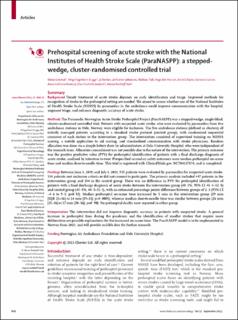| dc.description.abstract | Background Timely treatment of acute stroke depends on early identification and triage. Improved methods for
recognition of stroke in the prehospital setting are needed. We aimed to assess whether use of the National Institutes
of Health Stroke Scale (NIHSS) by paramedics in the ambulance could improve communication with the hospital,
augment triage, and enhance diagnostic accuracy of acute stroke.
Methods The Paramedic Norwegian Acute Stroke Prehospital Project (ParaNASPP) was a stepped-wedge, single-blind,
cluster-randomised controlled trial. Patients with suspected acute stroke, who were evaluated by paramedics from five
ambulance stations in Oslo, Norway, were eligible for inclusion. The five ambulance stations (defined as clusters) all
initially managed patients according to a standard stroke protocol (control group), with randomised sequential
crossover of each station to the intervention group. The intervention consisted of supervised training on NIHSS
scoring, a mobile application to aid scoring, and standardised communication with stroke physicians. Random
allocation was done via a simple lottery draw by administrators at Oslo University Hospital, who were independent of
the research team. Allocation concealment was not possible due to the nature of the intervention. The primary outcome
was the positive predictive value (PPV) for prehospital identification of patients with a final discharge diagnosis of
acute stroke, analysed by intention to treat. Prespecified secondary safety outcomes were median prehospital on-scene
time and median door-to-needle time. This trial is registered with ClinicalTrials.gov, NCT04137874, and is completed.
Findings Between June 3, 2019, and July 1, 2021, 935 patients were evaluated by paramedics for suspected acute stroke.
134 patients met exclusion criteria or did not consent to participate. The primary analysis included 447 patients in the
intervention group and 354 in the control group. There was no difference in PPV for prehospital identification of
patients with a final discharge diagnosis of acute stroke between the intervention group (48·1%, 95% CI 43·4–52·8)
and control group (45·8%, 40·5–51·1), with an estimated percentage points difference between groups of 2·3 (95% CI
–4·6 to 9·3; p=0·51). Median prehospital on-scene time increased by 5 min in the intervention group (29 min
[IQR 23–36] vs 24 min [19–31]; p<0·0001), whereas median door-to-needle time was similar between groups (26 min
[21–36] vs 27 min [20–36]; p=0·90). No prehospital deaths were reported in either group.
Interpretation The intervention did not improve diagnostic accuracy in patients with suspected stroke. A general
increase in prehospital time during the pandemic and the identification of smaller strokes that require more
deliberation are possible explanations for the increased on-scene time. The ParaNASPP model is to be implemented in
Norway from 2023, and will provide real-life data for further research. | en_US |

